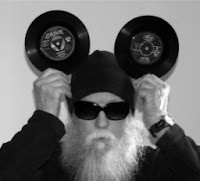When you want your jaaazz to be smooth on the draw with no harsh aftertaste, when the mood is mellow and the lights are low, you'll reach for these sophisticated selections with confidence! Say yes to no harsh atonality! Say yes to "no free jazz here, buddy! We's paying customers!" When you got a dame draped in your lap, last thing you need is some boho overblowing his reed in a challenging attempt to raise your consciousness! That's why we here at th' Foam like our jaaazz stirred, not shaken!
George Shearing - boring name, boring guy! - is better known for his bespectacled piano stylings than this one-of-a-kind chamber jazz offering. It got kicked to death by every beret-wearing bluenose who knew True Jazz when he heard it, and he certainly wasn't hearing it on '64's Out Of The Woods. But, candidly, who gives a fuck, right? This is composed and arranged to the last hemi-demi-quaver. No blowing, just an unclassifiable selection of exquisitely lovely tunes. I'm told there's counterpoint a-plenty, but don't let that put you off. Reference point for psychonauts: Zappa's melodic interludes.








































